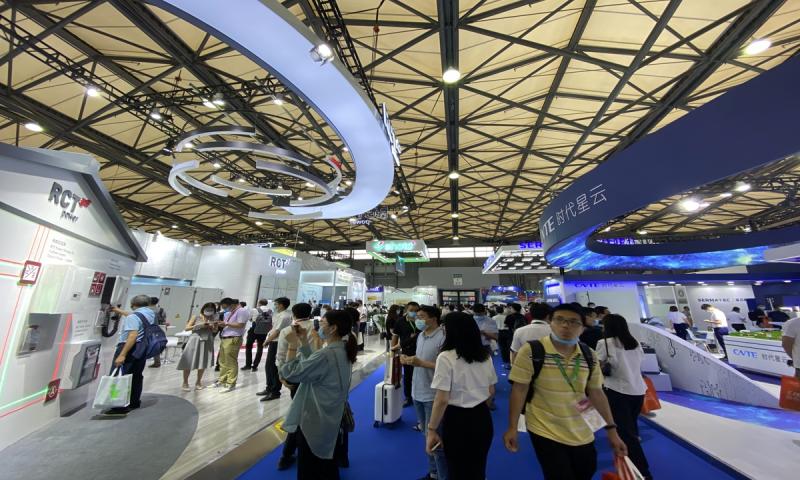Even while the coronavirus pandemic still impedes personnel exchanges in business sector as global travels are disrupted, the world solar industry practitioners were paying attention to a major industry exhibition recently after more than 140 countries and regions around the world had made net-carbon or carbon-neutrality goals.
 The 2021 SNEC International Photovoltaic Power Generation and Smart Energy Conference & Exhibition attracts a great number of visitors on Thursday in Shanghai. Photo: Zhang Dan/GT
The 2021 SNEC International Photovoltaic Power Generation and Smart Energy Conference & Exhibition attracts a great number of visitors on Thursday in Shanghai. Photo: Zhang Dan/GT
The 2021 SNEC International Photovoltaic Power Generation and Smart Energy Conference & Exhibition was held from Wednesday to Saturday in Shanghai. According to exhibitors, the number of participants and level of interest shown by visitors were both much higher than that last year.
Many suggest this trend is related to China's goals to reach carbon peak by 2030 and carbon neutrality by 2060.
Liu Hanyuan, executive chairman of the Asian Photovoltaic Industry Association, said at Wednesday's conference that the dual-carbon goal is one of China's most important statements to the world after it contained the COVID-19.
"China's timetable has a significant influence on the Europe, US, Japan and South Korea. It will create momentum throughout the world's sustainable development in the new century," Liu said.
As China has become the world's largest solar and wind power market , its installed capacity demand and annual growth for new energy means huge opportunities for both domestic and foreign companies.
Bureau Veritas, a French company focused on testing, inspection and certification services, said in a statement to the Global Times that the huge market potential, growing technical maturity and China's commitment to developing new energy have created increased confidence to its development in the Chinese market.
Dominance won't change
To achieve China's stated goals, solar energy is regarded as one of the most stable and economical new energy resources.
However, the development of China's photovoltaic (PV) industry, especially in overseas markets, is facing severe challenges while the Europe and the US continue to attempt to crackdown of Chinese market players, industry experts and company executives said.
Wang Guiqing, vice chairman of the China Chamber of Commerce for Import and Export of Machinery and Electronic Products and executive director of the Solar Photovoltaic Products Branch, said at the conference that the PV market particularly needs a fair global trading environment, Wang Guiqing, vice chairman of the China Chamber of Commerce for Import and Export of Machinery and Electronic Products told at a panel discussion at the conference.
According to a report by the chamber, since the US initiated the imposition of anti-dumping and countervailing duties on Chinese PV products, Chinese PV products have suffered 14 trade remedy investigations by countries and regions including the US, the EU, India, Australia, Canada and Turkey, with the cumulative amount of money involved hitting about $30 billion.
"[Trade remedy] investigations on China's PV industry has no big relationship with the changes of other countries' term of office. As long as the local industry submits an application, the local administrative department could put on record and initiate the investigation," Wang said.
However, frequent trade frictions have not lead to the failure of China's PV industry, but have become a catalyst for industrial transformation and upgrading, prompting Chinese companies to accelerate global layout and expand diversified markets.
For example, JA Solar has started to build its industrial supply chain in Southeast Asia since 2015; LONGi Group established a production base in Malaysia in 2016. Currently, Chinese PV products are sold to more than 200 countries and regions with their overseas production capacity exceeding 40GW.
At the exhibit, Lian Chengrong, chief operating officer at Sunman Energy, a lightweight solar panel producer, said China's advantages and dominance in the PV industry won't change in short term.
"China's PV industry has achieved full advantages in the entire industrial chain over the past decades. Its position in the prospective overseas market won't change," Lian told the Global Times.
Even if the Europe proposed to bring its PV sector back to the region, and the US also suggested bringing manufacturing back to the country, which may cause pressure to the new PV technologies and increasing investment on the R&D by foreign countries, PV industrialization is unlikely to significant shift away from China, according to Lian.
In addition to exploring the overseas markets, more Chinese PV companies also aim to grasp the lucrative domestic markets. "Against the backdrop of coronavirus pandemic and global trade frictions, we are weighing more on the "walking on two legs" strategy, Lian noted, adding the company is promoting the sales and marketing in East China's Shandong Province, North China's Hebei Province and Central China's Henan Province.